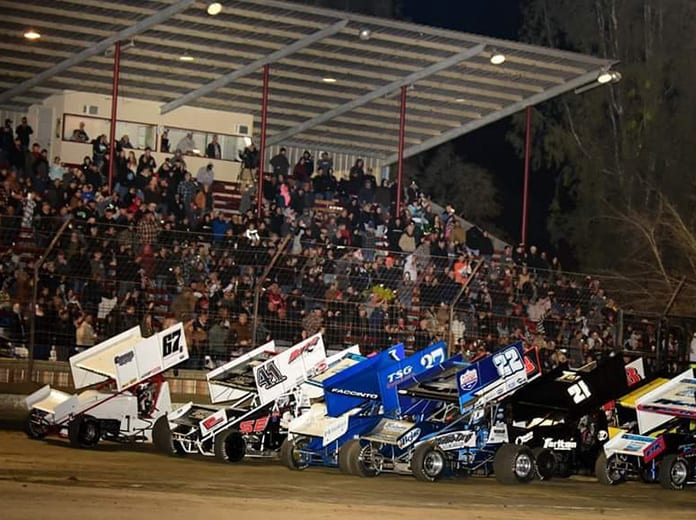
It’s safe to say Murphy made a good first impression on the crowd. In three weeks, Murphy had rejuvenated the dust-worn facility with fresh paint, new walls, landscaping and signage with the help of many local companies, some of whom are familiar to race fans for their sprint car sponsorships, such as Tarlton Construction, Roth Cattle Co., Netto Agriculture and Elite Landscaping.
Murphy also reconfigured the track to eliminate what he thought were drawbacks to putting on a good show, based on his own experience racing there. “I was not a fan of it before,” Murphy confessed. “I wanted to make it racy but technical, so you have to pay attention the whole time.”
“The track was too wide and the infield was too narrow, so you couldn’t slide a guy without running out of race track,” explained Dominic Scelzi. “The new shape is as wide as Knoxville (Raceway in Iowa) and it will make for some great racing.”
Stidham believes Murphy’s ability to see things from both sides of the fence will make the track more successful.
“To be a good promoter you need to know the racer side of things,” Stidham said. “If racers are happy, they will bring fans.”
COVID-19-related crowd restrictions have hampered Murphy’s schedule since opening night. But he insists that the track’s main attraction will be sprint cars, including the track’s own winged 360 and RaceSaver series and 410s of the King of the West Series, which are featured in Hanford’s traditional big show, the Cotton Classic, normally run in October. “I’d like to add a couple more 410 shows because I want them to survive,” Murphy said.
Murphy is considering replacing traditional formats in the name of showmanship. There might be twin 20-lappers with the field inverted in the second race from their finish in the first, he suggested. A pole shuffle, an Australian tradition that turns a fast car dash into a gunslinger-style shootout, might show up as well.
“The format is not set in concrete and it’s not going to be normal every week,” Murphy said. “It’s my bat and ball, so racers will have to play by my rules.”
One race that will not be added to Hanford’s schedule is the Peter Murphy Classic, which will remain at Thunderbowl Raceway, though this year’s event was canceled.
“I have a good relationship with (promoter) Steve Faria and a lot of respect for what he has done to promote that race,” Murphy said.
The success of the Peter Murphy Classic, which offers a large purse, is the polar opposite of a black July night in 2013 when a crash sucked the air out of Antioch Speedway like a galactic black hole.
Murphy was running near the front of a King of the West race and shooting for a hole between the frontstretch wall and a lapped car. Seconds later, his sprint car was upside down with the roll cage facing traffic that was coming at him like a freight train. The crowd collectively gasped and held its breath as the impact made its impression on them; a full grandstand as quiet as a church service as the safety crew raced to the crash.
“Basically, I got hit in the head by a sprint car,” Murphy explained a year or so later.
His injuries were extensive with the most serious of them being a moderate brain trauma, blood on the brain and a compression fracture of his T3 vertebra. Recovery was a long arduous process that required nearly a dozen different medical specialists.
The healing took many months as Murphy’s everyday life was put on hold. In addition to medical expenses, his healing took a toll on the family’s financial life, including the ability to run his sign-making business in Fresno.
“My wife kept the business going, but the income went down,” Murphy recalled. “But without the benevolent fund, we might not have been able to keep it,” he added, referring to a fund created in 1993 by the Northern Auto Racing Club.
For the last seven years, he has promoted the Peter Murphy Classic to raise funds and to show his gratitude to the people who helped he and his family during his recovery.
The unassuming Murphy, who seems to be more popular in some parts of Fresno than the mayor and the beer distributor combined, is unfazed by the attention directed at him personally and maintains his focus on the primary purpose of the Peter Murphy Classic.
“We’ve given more money back to the benevolent fund than we received,” Murphy noted. “What’s really important is that the money is there for someone else if they need it.”
After getting his promotional feet wet with the Classic, Murphy is shifting gears to manage an entire season-long racing program. He is realistic about the challenges. “There are so many moving parts to make it work,” he said. “You can’t just sit and let the program fade.”
But in a form of pre-destiny, he believes he is the right person at the right time to rejuvenate Hanford/Keller Auto Speedway.
“I think this is what I was intended to do,” Murphy said. “Growing up in Australia, all I wanted to do was race a car. I chased my dream my whole life and this is just another way to continue that chase.”
